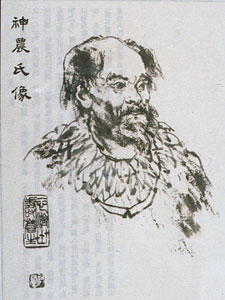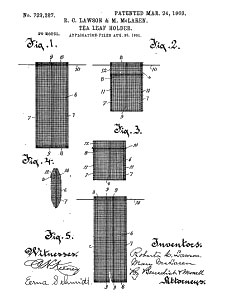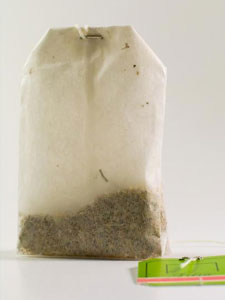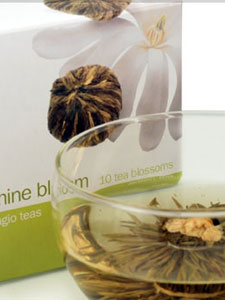A History of Teabags




What is that monstrous concoction bobbing in your cup? If you've just answered "it's just a tea bag," we need to talk.
In this installment of your favorite Tea Newsletter, I will tackle one of the most difficult problems facing modern tea: the popularity (and inferiority) of teabags. Nowadays, tea bags make up about 95% of all tea sales in the US. These bags, however, usually contain the cheapest tea available, producing little more than a brown-colored liquid. Doesn't sound too appetizing, huh? With this as the popular standard, it's not surprising that tea's popularity in the United States has faded.
Although a relatively new invention, it has now become the Camellia's spokesperson. But this low-quality product was not always the norm for tea.
When the first leaf fell in Shen Nung's cup, did it have a labeled string attached? I think not. For centuries, tea was enjoyed in a loose form, employing a variety of different methods to separate the leaves from the water. There have been several ancient books recovered which provide detailed instructions and advice on how to best enjoy tea. The most famous of these teachings (apart from my soon-to-be released guide) was written around 800 AD by Chinese philosopher Lu Yu, called the Ch'a Ching. Surprisingly, there are no passages indicating that the tea should be "removed from the wrapper by pulling the string."
The first tea bags were inadvertently made from hand-sewn silk muslin bags. Thomas Sullivan, a tea and coffee merchant from New York City, tried to cut sampling costs by sending loose tea in small silk sacks (instead of costly tins, which was what most merchants used at the time). Potential clients, confused by this new packaging, threw the tea in hot water—bag and all. Thomas started getting many requests for these "teabags" and realized that he had struck gold. The quick and easy clean-up of the leaves (due to the fact that they were still contained in the silk bag) made it enticingly convenient. Teabags first began appearing commercially around 1904, and quickly shipped around the world.
Unfortunately, however, this convenience came at a high price: flavor. Using bags created the problem of improper expansion of leaves. In order for a tea leaf to fully infuse all flavor possible, it needs a great deal of room to expand. Because teas in teabags got less leg room, the quality was diminished. What was the solution? Smaller leaves. This way, they needed less room to enlarge. Due to the fact that they were hidden behind a silk screen anyway, little attention was given to this fact.
With this decision, the slippery slope of tea began. Because size no longer mattered, merchants could purvey much cheaper grades of tea known as "fannings" or "dust." These are the lowest rankings that tea can achieve, found at the bottom of the tea barrels - sure, they'll add color to your cup, but not nearly as much flavor. After this, companies began to wrap the "leaves" in paper filters, a much cheaper alternative that didn't allow water to flow through to the cup as easily, excluding even more quality.
This state of tea mediocrity has now plagued the West for several decades. Most supermarkets still offer only a bottom-of-the-barrel tea product, leaving most consumers to believe that there is nothing better available. But this is a far cry from the abundance of flavor and intoxicating aroma found in a cup of full-leaf gourmet tea.
Recently, tea vendors have begun brainstorming on ways to tackle this problem. How can they maintain the convenience that consumers have grown accustomed to without sacrificing the quality? One answer that they've come up with is making waves: larger leaves in better bags. Thanks to modern technology, these companies are now able to use a higher-quality nylon bag that allows for more water to flow through, bringing more flavor into the cup. So to distance themselves from their inferior dust-filled cousins, these new bags are referred to as "tea sachets." A delicious example of such a product is Adagio's realiTEA sachets.
Another solution to the "tea bag dilemma" is much simpler: making loose tea strainers more effective and convenient. Poor filtration and messy clean-up have turned off many interested tea drinkers, barring them from the superior quality of loose tea. Americans demand convenience, and spooning loose tea out of a cup (after spending twenty minutes cleaning the tea ball) is no longer acceptable. However, there are interesting new teapots that fill this position nicely. A great example of an ingenious teapot is Adagio's ingenuiTEA teapot.
A complete renovation of the Western mindset on tea may seem like a longshot, but remember this: there once was a time when your choice of coffee ranged from Folgers to Sanka. Then, Starbucks came along to show how much better it can be. The same is true of tea. Most folks are no longer drinking Sanka. Once they try gourmet-quality tea, they will not wish to drink anything currently sold in the supermarket either.
